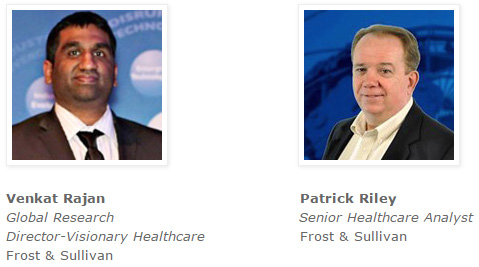PRESENTER
Greg Caressi
Senior Vice President,
Transformational Health
Frost & Sullivan
Greg Caressi
Senior Vice President,
Transformational Health
Frost & Sullivan
SESSION ABSTRACT
This discussion helped participants gain valuable insight into new marketplaces and implications across value chains. Examples of how transformation in healthcare can be leveraged to develop new business models were also presented. Participants examined top global case studies and utilized them to identify new channel partners, new customers, new convergence ideas and revenue streams across the entire ecosystem.
KEY TAKE-AWAYS:
This discussion helped participants gain valuable insight into new marketplaces and implications across value chains. Examples of how transformation in healthcare can be leveraged to develop new business models were also presented. Participants examined top global case studies and utilized them to identify new channel partners, new customers, new convergence ideas and revenue streams across the entire ecosystem.
KEY TAKE-AWAYS:
- An assessment of the future success potential of current and emerging business models in the B2B and B2C segments across industries
- Identification of new partner networks, future customer segments and valuable revenue streams for your company
- Analysis of new product positioning, new value proposition through creation of a business model canvas
OVERVIEW
Healthcare is being transformed and new business models are evolving around six overall themes:
- Building an Ecosystem
- Moving from Product to Service
- Decision Support
- Integration Is King
- Process Change
- Mass Customization
Some key developments in new healthcare business models include:
- Artificial Intelligence solutions being used for workflow optimization (e.g., triage) purposes
- The use of social media, more on the consumer side than the institutional side, for purposes such as activity coaching
- The tendency to view market segmentation and/or fragmentation as an opportunity where one solution can be adapted across various stakeholders
- Enhanced patient comfort level with having their information reside in the cloud
- Consumer willingness to co-pay seems set at around $30-$50
- Genomics is one new area of innovation in business models; within 5 years it willbe considered ―malpractice not to use some genomics technologies, particularlyin oncology
- Intermountain Healthcare is one of the leaders in offering healthcare providers genomics testing
- IBM Watson is partnering with Memorial Sloan Kettering to leverage genomics and analytics
- The American Society of Clinical Oncology (ASCO) is partnering with Systems, Applications and Processes in Data Processing (SAP) to develop big data solution for oncologists nationwide
- Shared infrastructure platforms are being shared across practice groups
TAKE-AWAY
- 64% of patients would see a doctor via video
- Access and convenience is more important to patients than physical contact, many are also very unconcerned with having their information in the cloud
- Price points are similar for most available options (makes things easier)
- You can adapt one technology and one solution to many different stakeholders
ACTION ITEM
- Strive to change consumer attitudes towards healthcare delivery
BEST PRACTICE
- Reimburse only for the best pathway of healthcare delivery
- Artificial Intelligence (AI) is used for determining models and learning from them
- Find an enterprise based analytics solution located within a clinical setting
- Speed up ingestion and analytics of data
- Find the balance between one on one and subscription based model
- Retail clinics have an opportunity to provide a positive impact for minor issues
- A lot of different parts when it comes to chronic care leads to new models,
- While many in the field are reducing interaction with it, the FDA is still a central player; you need to worry about the FDA
- The first conflict point will probably be provider-payer not consumer-payer
- Cloud is the new change that has to happen, there is just too much data to house physically
FINAL THOUGHT
With
the coming influx of technology and the growing consumer adoption rate,
you need to really position yourself within the field and make use of
the tools and analytics that are becoming increasingly more available.
Cloud storage and the upcoming use of AI to help interpret all of this
data in a meaningful way will be the key to success.






